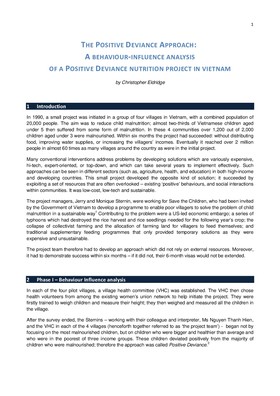The Positive Deviance approach to malnutrition – a behaviour-influence analysis
In 1990, a small project was initiated in a group of four villages in Vietnam, with a combined population of 20,000 people. The aim was to reduce child malnutrition; almost two-thirds of Vietnamese children aged under 5 then suffered from some form of malnutrition. In these 4 communities over 1,200 out of 2,000 children aged under 3 were malnourished. Within six months the project had succeeded: without distributing food, improving water supplies, or increasing the villagers’ incomes. Eventually it reached over 2 million people in almost 60 times as many villages around the country as were in the initial project.
Many conventional programmes address problems by developing solutions which are variously expensive, hi-tech, expert-oriented, or top-down, and which can take several years to implement effectively. Such approaches can be seen in different sectors (such as, agriculture, health, and education) in both high-income and developing countries. This small project developed the opposite kind of solution; it succeeded by exploiting a set of resources that are often overlooked – existing ‘positive’ behaviours, and social interactions within communities. It was low-cost, low-tech and sustainable.
Cite this publication
Available at https://www.iied.org/g03637
